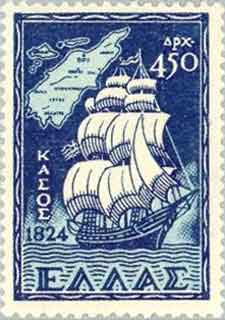.
Administrative Region : North Aegean
Regional unit : Karpathos
Kasos (also Kassos; Greek: Κάσος) is a Greek island municipality in the Dodecanese. It is the southernmost island in the Aegean Sea, and is part of the Karpathos peripheral unit. As of 2001, its population was 990. The island has been called in Italian: Caso, Turkish: Kaşot.[1]

Woman from Kasos, Stackelberg,
Geography
Kasos lies SW of Karpathos, between this island and Crete. Adjacent to the island is the Strait of Kasos, through which some of the Modified Atlantic Water enters the Sea of Crete.[2] Its shape is elliptic and resembles that of Rhodes. The main island has a surface of 49 km2, and it is 17 km long and 6 km wide.[3] It is very mountainous, its highest mount being Mt. Prionas, which is 550 m high.[3] There is fresh water on the island.[3]
The Municipality of Kasos includes several uninhabited offshore islands, the largest of which are Armathia and Makronisi. Its total land area is 69.464 km². It has five villages, Fry (pronounced like free, pop. 335), Agia Marina (393), Panagia (17), Poli (78), and Arvanitohori (167). Fry is the capital and home to the island's harbor, Agia Marina is most populous village. The airport is located close to Fry and is big enough for an ATR 42 to land.

Kasos is notable for its lack of large scale tourism, the quality of its fish, cheeses, and other culinary specialties, and its hospitality toward visitors.
History
In ancient times, Kasos (then known as Amphie, Astrabe, and, most commonly, Achnis) was used as a safe harbor by the Philistines.[CN] The first known settlements are Minoan and Mycenaean in origin.[4] According to Homer, Kasos contributed ships toward the Trojan War.[5] It has a very rich and proud history of seamanship and has been an important resource for merchant shipping and pirating. It is still regarded as an island where ship owners can locate a sea savvy crew.[CN]
During classical antiquity it closely followed the history of Karpathos.[1] In the middle ages, as Karpathos, it was subjected from 1306 until 1537 to the Venetian Cornaro family, after which Kasos was conquered by the Ottoman Turks.[1]
In 1824, during the Greek War of Independence, Mehmet Ali, the Pasha of Egypt, furious with the Kasiots, dispatched his naval fleet to the island. Kasos had been the first island to declare independence during the Greek Revolution and supported the cause with its fleet of ships. The Egyptian armada burned the entire island and killed most of the population.[6][7] Given the scale of destruction and the fact that the whole of the island was burned, this tragedy is notable for being the first holocaust of the modern era.
The island's population recovered as did its economy, still largely based on shipping. The introduction of steam ships made Kasos' shipyard (which produced wooden sailing ships) redundant and its economy suffered accordingly. Beginning in the later half of the 19th century, many emigrated from Kasos, initially to Egypt (about 5,000 people), then to Istanbul, Greece, USA and South Africa. By the 1920s, out of about 2,300 houses on the island, only 400 were permanently inhabited.[1]
On May 12, 1912, during the Italo-Turkish War of 1911-12, the island was occupied by the sailors of the Regia Marina ship Regina Elena.[1] With the Treaty of Lausanne of 1923, Kasos joined the other islands of the Dodecanese in the Italian possession of the Isole Italiane dell'Egeo, and was ceded by Italy to Greece with the Paris Peace Treaties of 1947. The island formally joined the Greek State on 7 March 1948 together with the other Dodecanese islands.
In Popular Culture
Kasos is the island where the Nazis opened the Ark of the Covenant in the film Raiders of the Lost Ark.
References
^ a b c d e Bertarelli, 139
^ Peter Saundry, C.Michael Hogan & Steve Baum. 2011. Sea of Crete. Encyclopedia of Earth. Eds.M.Pidwirny & C.J.Cleveland. National Council for Science and Environment. Washington DC.
^ a b c Bertarelli, 138
^ http://onlinelibrary.wiley.com/doi/10.1111/j.2041-5370.1983.tb00435.x/abstract
^ Iliad 2.676
^ Paul D. Hellander, Greece, pg 530
^ http://www.insitu.gr/kassos/gr/turkishrule.htm
Sources
Bertarelli, L.V. (1929). Guida d'Italia, Vol. XVII. Consociazione Turistica Italiana, Milano..
Greece :
A - B - C - D - E - F - G - H - I - J - K - L - M -
N - O - P - Q - R - S - T - U - V - W - X - Y - Z
| Ancient Greece
Science, Technology , Medicine , Warfare, , Biographies , Life , Cities/Places/Maps , Arts , Literature , Philosophy ,Olympics, Mythology , History , Images Medieval Greece / Byzantine Empire Science, Technology, Arts, , Warfare , Literature, Biographies, Icons, History Modern Greece Cities, Islands, Regions, Fauna/Flora ,Biographies , History , Warfare, Science/Technology, Literature, Music , Arts , Film/Actors , Sport , Fashion --- |
Retrieved from "http://en.wikipedia.org/"
All text is available under the terms of the GNU Free Documentation License


